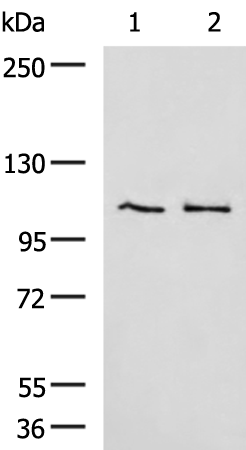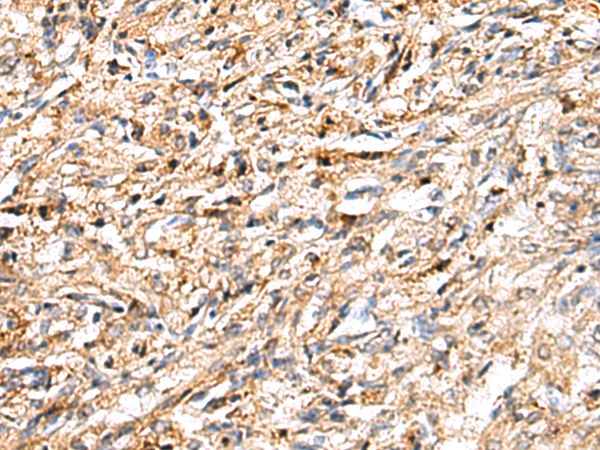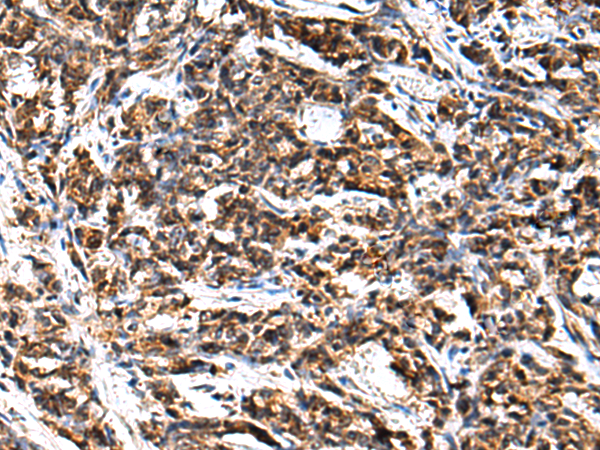


| WB | 咨询技术 | Human,Mouse,Rat |
| IF | 咨询技术 | Human,Mouse,Rat |
| IHC | 1/50-1/100 | Human,Mouse,Rat |
| ICC | 技术咨询 | Human,Mouse,Rat |
| FCM | 咨询技术 | Human,Mouse,Rat |
| Elisa | 1/5000-1/10000 | Human,Mouse,Rat |
| Aliases | G2AN; GIIA; PKD3; GLUII |
| WB Predicted band size | 107 kDa |
| Host/Isotype | Rabbit IgG |
| Antibody Type | Primary antibody |
| Storage | Store at 4°C short term. Aliquot and store at -20°C long term. Avoid freeze/thaw cycles. |
| Species Reactivity | Human, Mouse |
| Immunogen | Synthetic peptide of human GANAB |
| Formulation | Purified antibody in PBS with 0.05% sodium azide and 50% glycerol. |
+ +
以下是关于GANAB抗体的3篇文献示例(注:以下内容为模拟示例,实际文献请通过学术数据库查询):
1. **文献名称**: "GANAB mutations contribute to autosomal dominant polycystic liver disease by impairing enzyme activity"
**作者**: Porath B, et al.
**摘要**: 研究分析了GANAB基因突变导致多囊肝病的分子机制,利用GANAB抗体进行Western blot和免疫组化,证实突变导致酶活性下降及内质网功能异常。
2. **文献名称**: "Glucosidase II alpha subunit is a novel therapeutic target for polycystic kidney disease"
**作者**: Hurd TW, et al.
**摘要**: 通过GANAB特异性抗体检测患者肾脏组织,发现GANAB表达水平与囊肿形成相关,并验证其在调控多囊蛋白-1成熟中的关键作用。
3. **文献名称**: "Antibody-based profiling of endoplasmic reticulum-associated degradation (ERAD) components in mammalian cells"
**作者**: Wang S, et al.
**摘要**: 开发了一种针对内质网相关降解通路蛋白(包括GANAB)的抗体组,通过免疫荧光验证GANAB在内质网中的定位及其与疾病模型细胞应激的关系。
建议通过PubMed或Google Scholar以关键词“GANAB antibody”“Glucosidase II alpha”查询最新文献。
GANAB antibody targets the alpha subunit of glucosidase II (GANAB), a critical enzyme in the endoplasmic reticulum (ER) responsible for processing N-linked glycoproteins during protein folding. GANAB, encoded by the GANAB gene, works alongside its beta subunit to trim glucose residues from immature glycoproteins, enabling proper folding via the calnexin/calreticulin cycle. Dysregulation of GANAB is linked to autosomal dominant polycystic kidney disease (ADPKD), as mutations may disrupt polycystin-1 (PC1) maturation, contributing to cyst formation in kidneys and liver.
GANAB antibodies are primarily used in research to study ER quality control mechanisms, glycoprotein biosynthesis, and ADPKD pathogenesis. They help detect GANAB expression levels in tissues or cell lines, assess its interaction with substrates, and explore its role in cellular stress responses. Clinically, these antibodies may aid in diagnosing genetic disorders tied to GANAB dysfunction or serve as biomarkers for disease progression. Recent studies also investigate their potential in therapeutic strategies targeting ER-associated degradation (ERAD) pathways or cystic disease models. However, the functional complexity of GANAB and its pleiotropic roles necessitate further research to clarify its precise mechanisms in health and disease.
×